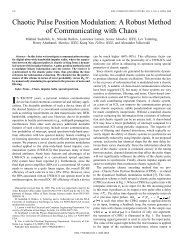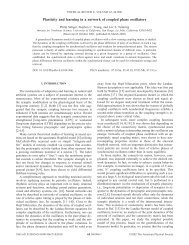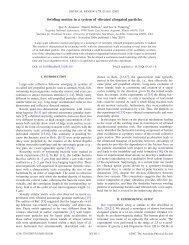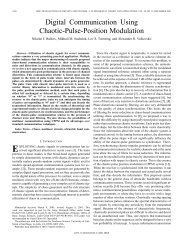A fast, robust and tunable synthetic gene oscillator - The BioCircuits ...
A fast, robust and tunable synthetic gene oscillator - The BioCircuits ...
A fast, robust and tunable synthetic gene oscillator - The BioCircuits ...
Create successful ePaper yourself
Turn your PDF publications into a flip-book with our unique Google optimized e-Paper software.
doi: 10.1038/nature07389 SUPPLEMENTARY INFORMATION<br />
fraction Fraction oscillating<br />
1<br />
0.8<br />
0.6<br />
0.4<br />
0.2<br />
0<br />
0.1 times original delay−related rates<br />
original parameters<br />
10 times original delay−related rates<br />
100 times original delay−related rates<br />
0 0.5 1 1.5 2 2.5 3 3.5<br />
Arabinose<br />
ARA<br />
(%)<br />
Supplementary Figure 22: A numerical investigation of the effect of changing intracellular delay on<br />
<strong>robust</strong>ness. This was investigated by probing the nearby parameter space for <strong>oscillator</strong>y behavior. All<br />
parameters were r<strong>and</strong>omly sampled independently <strong>and</strong> uniformly (in log-space) between half <strong>and</strong> double<br />
their listed values. This approach was chosen to avoid preferential treatment of a particular set of the 21<br />
varied parameters (Gutenkunst et al. 2007): k ℓ, k uℓ, ba, br, α, ta, tr, k f a, k f r, k da, k −da, k dr, k −dr, kt, k−t,<br />
da, dr, γ, ce, ɛ, λ. Initial conditions consisted of all promoters in the looped state with two bound repressor<br />
proteins (“PL,2”), zero mRNA levels, <strong>and</strong> zero protein levels for all but folded monomeric forms (“a” <strong>and</strong> “r”),<br />
which were uniformly sampled between 0 <strong>and</strong> 500 for both activator <strong>and</strong> repressor. A computed trajectory<br />
was determined to not be <strong>oscillator</strong>y if, after a transient of 2000 min, the maximal variation in the number<br />
of folded monomeric activator (“a”) was less than 0.1 in a subsequent 400 min of simulation. <strong>The</strong> plot<br />
displays the fraction of <strong>oscillator</strong>y states for varying levels of arabinose <strong>and</strong> 2.0 mM IPTG. This procedure<br />
was repeated for different mean values of certain delay-related rates, being done by multiplying the listed<br />
parameter values for the forward rates of folding, dimerization, <strong>and</strong> tetramerization by some common value<br />
(listed in the figure legend). Error bars were set to the maximum st<strong>and</strong>ard deviation σmax = 0.5/ √ N for<br />
the average of N = 200 Bernoulli trials. <strong>The</strong> data supports that decreasing the delay in the system tends to<br />
reduce the fraction of <strong>oscillator</strong>y states in nearby parameter space, while increasing delay has the opposite<br />
effect.<br />
www.nature.com/nature<br />
31







